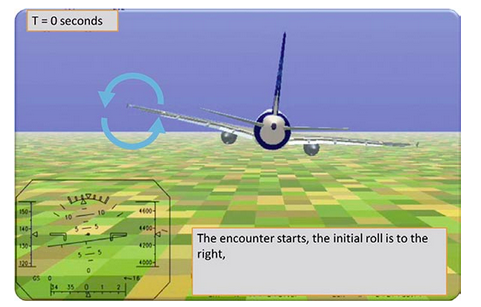
In Part 1, we discussed four incidents involving airliner upsets.
Dr. Richard Thackray of the FAA’s Civil Aeromedical Institute conducted a study to better understand pilot responses to potentially critical situations, such as unexpected clear air turbulence.
The study, titled “Performance Recovery Following Startle: A Laboratory Approach to the Study of Behavioral Response to Sudden Aircraft Emergencies,” concluded that complex perceptual-motor behaviors, such as those a flight crew would make as a reaction to an abrupt aircraft motion, are likely to show disruption still being present for 10 sec. Evidence from several studies suggests that the ability to process information may be impaired for 17 to 60 sec. following a startling event.
Of course, it is vital for the control of an aircraft to keep it near the center of its maneuvering envelope.
The post-incident engineering analysis of these flight crew reported “upsets” has consistently found this large difference between the pilots’ perceptions of the aircraft’s upset versus the engineering data of the aircraft’s actual accelerations.
The scientific research confirms the limitations of pilot information processing during these startling events. It is natural for a pilot to be concerned by a sudden aircraft motion, especially if the motion is abrupt and seems to take the aircraft toward the limits of its maneuvering margins. Unfortunately, human perceptions have been woefully inaccurate and this, in turn, has contributed to inappropriate flight crew inputs that have aggravated the aircraft’s flight condition.
This leads to an inherent problem. When an aircraft reacts unexpectedly, such as during a wake turbulence encounter, how should the flight crew properly react in order to minimize the aircraft’s unwanted motions and allow it to return to a stable trajectory?
Immense Flight Test Program
It is vital to understand an aircraft’s stability and dynamic response to the unique airflow disruption caused by the rapid and unexpected motion. The explanation can only be provided by specialized aeronautical engineers with decades of in-depth experience in the complex topic of flight-vehicle dynamic response.
Fortunately, our industry has been provided an invaluable set of recommendations on this issue by engineering experts at Airbus Industries, which conducted the largest flight test campaign ever to investigate aspects of wake turbulence encounters. Airbus hand-picked a prestigious team of specialists with decades of proven expertise in the fields of flight dynamics and flight testing.
One of the principals was Capt. Claude LeLaie. The entire aviation industry would be hard-pressed to find a better qualified aeronautical engineer and test pilot to explore this phenomenon. LeLaie graduated from France’s top engineering school, École Polytechnique, as well as the École Nationale Supérieure de l'Aéronautique. Afterward, he flew advanced fighters in the military. He served 11 years as a flight test engineer at Centre d’Essais en Vol, the French Flight Test Center, responsible for testing military aircraft designs and maneuvers. Based upon his engineering excellence he was chosen to be the director of engineering at Socata, a position he held for five years. He then was recruited by Airbus, where he served seven years as a test pilot, then 14 years as director of its Flight Test Department. He has the further distinction of being the captain of the first flight of the A380 and A340-600.
This is an indication of the aeronautical engineering expertise on the Airbus team. The rest of the large team contained individuals with equally comparable engineering expertise gained from decades of work in this field.
Many of them had authored engineering studies in prestigious engineering journals that underwent the intense scrutiny of the peer-review process. This is much more than earning a bachelor’s degree in engineering.
These specialists have spent a lifetime of devoted study on the topic. If you want to see the degree of rigor involved in their work, you can search through engineering articles published in the American Institute of Aeronautics and Astronautics Journal of Aircraft.
The amount of flight data collected by the Airbus research program is immense and adds further credibility to its results.
From May 2005 through December 2007, Airbus conducted 77 flights that accumulated 308 flight hours, during which they encountered 1,041 wake turbulence events. A widely varying degree of automated and hand-flown penetration and recovery events were analyzed.
Lessons Learned From Deliberately Flying Into Wake Turbulence
This flight test data dispels a lot of the common opinions on the early sequence of events in a wake encounter.
On each data collection point, the following aircraft started by flying on a near-parallel flight track slightly to the right of the generating aircraft’s wake turbulence.
The trailing aircraft would then enter the right vortex of the lead aircraft. When the left wing of the trailing aircraft entered the vortex, it induced an angle of attack (AOA) increase on the outboard portion of the wing. This increases the lift higher on the left wing than on the right wing. Therefore, the initial rolling motion is actually away from the core of the vortex.
It is worth re-reading these previous sentences to re-emphasize the point that the initial seconds of a trailing aircraft reacting to another aircraft’s wake actually rolled the trailing aircraft away from the core. This is “good news” if a pilot doesn’t interfere at this point.
In fact, Airbus’ flight test team discovered that it is not possible to remain in a severe vortex for a long time as the rotating airflow on the wing and on the fin eject the aircraft from the vortex. This correlated well with the computer simulations utilizing advanced flight mechanics equations. The Airbus flight tests demonstrated that the stabilization of a large aircraft inside a vortex can only be obtained by voluntarily establishing a large sideslip angle. As airliners do not and should not fly with large sideslip angles, they cannot remain in a vortex.
In Part 3, we’ll continue our discussion of Airbus’ wake-turbulence flight-test program.






Comments